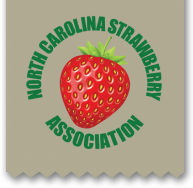Strawberries on plastic
The great majority of North Carolina strawberry farms use the “Southeastern plasticulture method.” Plants are set out into black plastic mulch in the fall of the year. Irrigation and some fertilization are supplied through “drip tape” laid under the plastic at the time of planting. The plants continue to grow during warmer periods over the fall and winter. In late winter and early spring they start to grow in earnest. Growers protect the early flowers from late frosts (March-April) with overhead irrigation at night. Many growers also use “row covers,” which are blankets of thin, translucent spun-bonded polyester, to protect their plants in cold weather. Though strawberries are perennial, plasticulture strawberries are grown as annuals, with harvest only 7-8 months after planting and new plants set out every year. Plant density is high (up to 17,500 plants per acre) and the farmers’ investment in the crop is substantial. Per-acre production: 15,000-25,000 lbs
Southeastern plasticulture was first developed by NC growers and NC State University researchers in the mid-1980s, adapting aspects of Florida and California production methods to the Carolina climate. This method has now spread to neighboring states and is being adapted to colder areas. North Carolina is recognized as a leader in plasticulture research and information.
Favorite plasticulture varieties:
Chandler:The leading variety, most widely planted for many years. Early plasticulture research showed that this California variety was especially well adapted to NC conditions. This high-yielding variety produces large, well-colored, juicy fruit.
Camarosa: A newer introduction from California, Camarosa has very large, dark red fruit. The fruit is firmer than Chandler and has a longer shelf life, so it is preferred for wholesale marketing. Camarosa is best when picked fully ripe and well colored.
Sweet Charlie: A variety from Florida, Sweet Charlie is the earliest ripening of our varieties. The fruit has a distinctive, very sweet flavor.
Bish & Galleta : These North Carolina varieties were developed by NC State University plant breeder Dr. Jim Ballington and released in 2002 (Bish) and 2006 (Galletta). They are disease-resistant and especially well suited to the upper Piedmont and Mountain regions.
Other varieties: Gaviota, Albion, Seascape, Camino Real, Strawberry Festival, Ventana, Treasure, and others, in smaller or experimental plantings. The North Carolina Strawberry Association supports NC State University research to breed new varieties especially adapted to this region, and several promising selections are currently being tested.
Matted row strawberries
The “matted row” method is used by many home gardeners and by some commercial growers, especially the northwestern Piedmont and Mountains. An older method that has been used for many, many years, matted row is also prevalent in colder regions of the United States. Plants are set out in spring or early summer on bare grown and allowed to send out runners with daughter plants that also take root, making a wider “matted” row. The first substantial crop comes the following year, about 12 months after planting. The field produces for 2-5 years and is then replanted. Per-acre production: 6,000-8,000 lbs.
Favorite matted row varieties: Earliglow, Allstar, Jewel, Honeoye, Delmarvel. Atlas, Apollo, and Titan, varieties developed in North Carolina, are no longer much used commercially but are still grown by some home gardeners. North Carolina has several nurseries that supply these matted row varieties.

